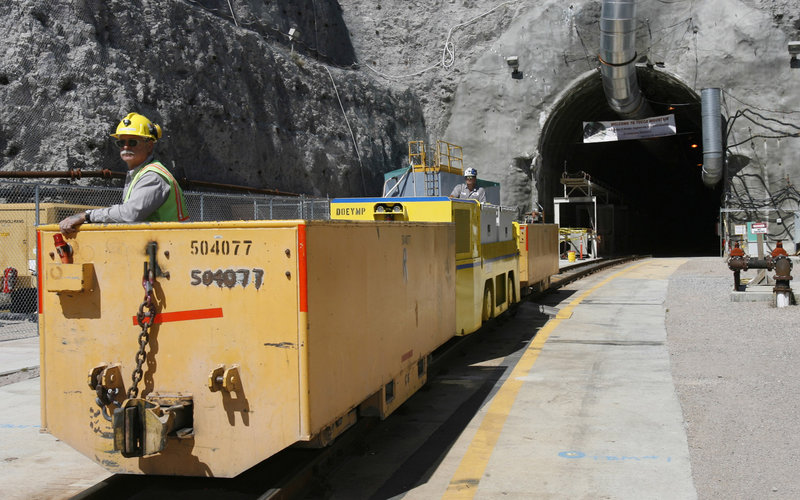The nuclear crisis in Japan has laid bare an ever-growing problem for the United States — the enormous amounts of still-hot radioactive waste accumulating at commercial nuclear reactors in more than 30 states.
The U.S. has 71,862 tons of the waste, according to state-by-state numbers obtained by The Associated Press. But the nation has no place to permanently store the material, which stays dangerous for tens of thousands of years.
Plans to store nuclear waste at Nevada’s Yucca Mountain have been abandoned, but even if a facility had been built there, America already has more waste than it could have handled.
Three-quarters of the waste sits in water-filled cooling pools like those at the Fukushima Dai-ichi nuclear complex in Japan, outside the thick concrete-and-steel barriers meant to guard against a radioactive release from a nuclear reactor.
Spent fuel at Dai-ichi overheated, possibly melting fuel-rod casings and spewing radiation into the air, after Japan’s tsunami knocked out power to cooling systems at the plant.
The rest of the spent fuel from commercial U.S. reactors has been put into dry cask storage, but regulators only envision those as a solution for about a century and the waste would eventually have to be deposited into a Yucca-like facility.
The U.S. nuclear industry says the waste is being stored safely at power-plant sites, though it has long pushed for a long-term storage facility. Meanwhile, the industry’s collective pile of waste is growing by about 2,200 tons a year; experts say some of the pools in the United States contain four times the amount of spent fuel that they were designed to handle.
The AP analyzed a state-by-state summary of spent fuel data based on information that nuclear power plants voluntarily report every year to the Nuclear Energy Institute, an industry and lobbying group. The NEI would not make available the amount of spent fuel at individual power plants.
While the U.S. Department of Energy previously reported figures on overall spent fuel storage, it no longer has updated information available. A spokesman for the U.S. Nuclear Regulatory Commission, which oversees nuclear power plant safety, said the agency was still searching for a compilation of spent fuel data.
The U.S. has 104 operating nuclear reactors, situated on 65 sites in 31 states. There are another 15 permanently shut reactors that also house spent fuel.
Four states have spent fuel even though they don’t have operating commercial plants. Reactors in Colorado, Oregon and Maine are permanently shut; spent fuel from all three is stored in dry casks. Idaho never had a commercial reactor, but waste from the 1979 Three Mile Island accident in Pennsylvania is being stored at a federal facility there.
Illinois has 9,301 tons of spent nuclear fuel at its power plants, the most of any state in the country, according to industry figures. It is followed by Pennsylvania with 6,446 tons; 4,290 in South Carolina and roughly 3,780 tons each for New York and North Carolina.
Spent nuclear fuel is about 95 percent uranium. About 1 percent are other heavy elements such as curium, americium and plutonium-239, best known as fuel for nuclear weapons. Each has an extremely long half-life — some take hundreds of thousands of years to lose all of their radioactive potency. The rest, about 4 percent, is a cocktail of byproducts of fission that break down over much shorter time periods, such as cesium-137 and strontium-90, which break down completely in about 300 years.
How dangerous these elements are depends on how easily can find their way into the body. Plutonium and uranium are heavy, and don’t spread through the air well, but there is a concern that plutonium could leach into water supplies over thousands of years.
Cesium-137 is easily transported by air. It is cesium-137 that can still be detected in a New Jersey-sized patch of land around the Chernobyl reactor that exploded in the Ukraine in 1986.
Typically, waste must sit in pools at least five years before being moved to a cask or permanent storage, but much of the material in the pools of U.S. plants has been stored there far longer than that.
Safety advocates have long urged the NRC to force utility operators to reduce the amount of spent fuel in their pools. The more tightly packed they are, the more quickly they can overheat and spew radiation into the environment in case of an accident, a natural disaster or a terrorist attack.
A 1982 law gave the federal government responsibility for the long-term storage of nuclear waste and promised to start accepting waste in 1998. After 20 years of study, Congress passed a law in 2002 to build a nuclear waste repository deep in Yucca Mountain.
The federal government spent $9 billion developing the project, but the Obama administration has cut funding and recalled the license application to build it. Nevadans have fiercely opposed Yucca Mountain, though a group of states and others are taking legal action to reverse the decision.
Despite his Yucca Mountain decision, President Obama wants to expand nuclear power. He created a commission last year to come up with a long-term nuclear waste plan. Initial findings are expected this summer, with a final plan expected in January.
Send questions/comments to the editors.



Success. Please wait for the page to reload. If the page does not reload within 5 seconds, please refresh the page.
Enter your email and password to access comments.
Hi, to comment on stories you must . This profile is in addition to your subscription and website login.
Already have a commenting profile? .
Invalid username/password.
Please check your email to confirm and complete your registration.
Only subscribers are eligible to post comments. Please subscribe or login first for digital access. Here’s why.
Use the form below to reset your password. When you've submitted your account email, we will send an email with a reset code.